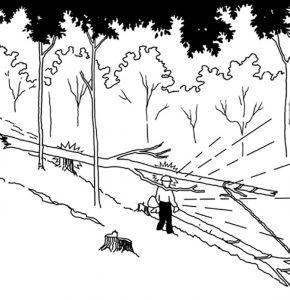 BACKGROUND: On a warm summer morning in the steep hills of the Appalachians, a timber cutter was felling hardwood trees in a small, brushy clear-cut.
BACKGROUND: On a warm summer morning in the steep hills of the Appalachians, a timber cutter was felling hardwood trees in a small, brushy clear-cut.
PERSONAL CHARACTERISTICS: The cutter was a 41-year-old trained feller with over twenty years of experience. He was wearing protective saw pants, hard hat, eye protection and safety boots.
UNSAFE ACTS AND CONDITIONS: The cutter was felling a tulip poplar that stood well above a dense canopy of saplings in the understory. He was unable to see the overstory clearly. He did not notice that a grapevine was connecting the top of the tree to another dead tree uphill from him. As the poplar tree began to fall downhill, the cutter stepped to the right slightly while looking downhill. He did not move far enough from the stump.
ACCIDENT: As the cutter released the poplar tree, the vines in the top of the tree pulled the dead tree downhill, hitting the cutter in the back and head and slamming him to the ground. He had not seen or heard the dead tree fall. Fortunately, a freshly cut stump absorbed much of the dead tree’s force just before it struck him. This buffering probably kept the tree from killing him.
INJURY: The dead tree crushed two of his vertebrae, broke four ribs, and gave him a concussion. Med flight took him to the hospital, where he received two 16-inch rods in his back and multiple clips and screws. The logger was off work for nearly nine months during his recovery.
RECOMMENDATIONS FOR CORRECTION: 1) Use extra caution when cutting trees in a dense canopy; take extra time to look for dead trees, vines, and other overhead hazards. Look up and around and through the forest canopy first. 2) Remove dead trees or other “danger trees” with the skidder before beginning manual felling in the immediate vicinity. 3) Do not remain at the stump after the tree is released, but retreat a safe distance in a diagonal direction away from the tree’s intended direction of fall. (One insurance company’s informal research found that over 75% of logging fatalities occurred within 8 feet of the stump.) 4) When overhead visibility is limited, use other trees as shield trees if they are available. 5) Hard hats save lives!
Supplied by Forest Resources Assn. https://forestresources.org/
